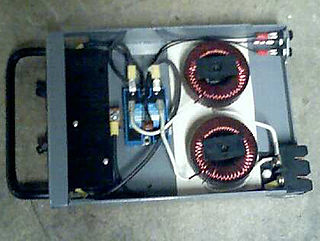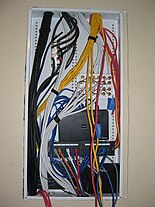
A programmable logic controller (PLC) or programmable controller is an industrial computer that has been ruggedized and adapted for the control of manufacturing processes, such as assembly lines, machines, robotic devices, or any activity that requires high reliability, ease of programming, and process fault diagnosis.

X10 is a protocol for communication among electronic devices used for home automation (domotics). It primarily uses power line wiring for signaling and control, where the signals involve brief radio frequency bursts representing digital information. A wireless radio-based protocol transport is also defined.

In electronics, a remote control is an electronic device used to operate another device from a distance, usually wirelessly. In consumer electronics, a remote control can be used to operate devices such as a television set, DVD player or other digital home media appliance. A remote control can allow operation of devices that are out of convenient reach for direct operation of controls. They function best when used from a short distance. This is primarily a convenience feature for the user. In some cases, remote controls allow a person to operate a device that they otherwise would not be able to reach, as when a garage door opener is triggered from outside.

Power-line communication, abbreviated as PLC, carries data on a conductor that is also used simultaneously for AC electric power transmission or electric power distribution to consumers.

A dimmer is a device connected to a light fixture and used to lower the brightness of the light. By changing the voltage waveform applied to the lamp, it is possible to lower the intensity of the light output. Although variable-voltage devices are used for various purposes, the term dimmer is generally reserved for those intended to control light output from resistive incandescent, halogen, and compact fluorescent lamps (CFLs) and light-emitting diodes (LEDs). More specialized equipment is needed to dim fluorescent, mercury-vapor, solid-state, and other arc lighting.

In electrical wiring, a light switch is a switch most commonly used to operate electric lights, permanently connected equipment, or electrical outlets. Portable lamps such as table lamps may have a light switch mounted on the socket, base, or in-line with the cord. Manually operated on/off switches may be substituted by dimmer switches that allow controlling the brightness of lamps as well as turning them on or off, time-controlled switches, occupancy-sensing switches, and remotely controlled switches and dimmers. Light switches are also found in flashlights, vehicles, and other devices.

A lighting control console is an electronic device used in theatrical lighting design to control multiple stage lights at once. They are used throughout the entertainment industry and are normally placed at the front of house (FOH) position or in a control booth.

The DMS-100 is a member of the Digital Multiplex System (DMS) product line of telephone exchange switches manufactured by Northern Telecom. Designed during the 1970s and released in 1979, it can control 100,000 telephone lines.

A pilot light is a small gas flame, usually natural gas or liquefied petroleum gas, which serves as an ignition source for a more powerful gas burner. Originally a pilot light was kept permanently alight, but this wastes gas. Now it is more common to light a burner electrically, but gas pilot lights are still used when a high energy ignition source is necessary, as in when lighting a large burner.

Profinet is an industry technical standard for data communication over Industrial Ethernet, designed for collecting data from, and controlling equipment in industrial systems, with a particular strength in delivering data under tight time constraints. The standard is maintained and supported by Profibus and Profinet International, an umbrella organization headquartered in Karlsruhe, Germany.

A lighting control system incorporates communication between various system inputs and outputs related to lighting control with the use of one or more central computing devices. Lighting control systems are widely used on both indoor and outdoor lighting of commercial, industrial, and residential spaces. Lighting control systems are sometimes referred to under the term smart lighting. Lighting control systems serve to provide the right amount of light where and when it is needed.

Digital Addressable Lighting Interface (DALI) is a trademark for network-based products that control lighting. The underlying technology was established by a consortium of lighting equipment manufacturers as a successor for 1-10 V/0–10 V lighting control systems, and as an open standard alternative to several proprietary protocols. The DALI, DALI-2 and D4i trademarks are owned by the lighting industry alliance, DiiA.
Universal Powerline Bus (UPB) is a proprietary software protocol developed by Powerline Control Systems for power-line communication between devices used for home automation. Household electrical wiring is used to send digital data between UPB devices via pulse-position modulation.
C-Bus is a communications protocol based on a seven-layer OSI model for home and building automation that can handle cable lengths up to 1000 metres using Cat-5 cable. It is used in Australia, New Zealand, Asia, the Middle East, Russia, United States, South Africa, the UK and, other parts of Europe including Greece and Romania. C-Bus was created by Clipsal Australia's Clipsal Integrated Systems division for use with its brand of home automation and building lighting control system. C-Bus has been briefly available in the United States but Schneider Electric has now discontinued sales in the United States.
An industrial control system (ICS) is an electronic control system and associated instrumentation used for industrial process control. Control systems can range in size from a few modular panel-mounted controllers to large interconnected and interactive distributed control systems (DCSs) with many thousands of field connections. Control systems receive data from remote sensors measuring process variables (PVs), compare the collected data with desired setpoints (SPs), and derive command functions that are used to control a process through the final control elements (FCEs), such as control valves.

A wireless light switch is a light switch that commands a light or home appliance to turn itself off or on, instead of interrupting the power line going to the light fixture. There are different ways to communicate between the switch and the fixture:
- Using radio transmission: A radio receiver is typically wired or screwed into a fixture or device, wired or otherwise connected to the electrical system of the building or plugged into an outlet. The radio receiver's memory is programmed by any number of means to respond to certain selected "switches" or remote control transmitters.
- Using the existing power lines : A receiver is plugged into an outlet and a device is then plugged into the receiver. The plug-in receiver is then programmed to the switches. Some devices are hard wired into ceiling light fittings, making for a hidden system.

An RF module is a (usually) small electronic device used to transmit and/or receive radio signals between two devices. In an embedded system it is often desirable to communicate with another device wirelessly. This wireless communication may be accomplished through optical communication or through radio-frequency (RF) communication. For many applications, the medium of choice is RF since it does not require line of sight. RF communications incorporate a transmitter and a receiver. They are of various types and ranges. Some can transmit up to 500 feet. RF modules are typically fabricated using RF CMOS technology.

A voltage controller, also called an AC voltage controller or AC regulator is an electronic module based on either thyristors, triodes for alternating current, silicon-controlled rectifiers or insulated-gate bipolar transistors, which converts a fixed voltage, fixed frequency alternating current (AC) electrical input supply to obtain variable voltage in output delivered to a resistive load. This varied voltage output is used for dimming street lights, varying heating temperatures in homes or industry, speed control of fans and winding machines and many other applications, in a similar fashion to an autotransformer. Voltage controller modules come under the purview of power electronics. Because they are low-maintenance and very efficient, voltage controllers have largely replaced such modules as magnetic amplifiers and saturable reactors in industrial use.
HomeSeer Technologies LLC is a technology company based in Bedford, New Hampshire, in the United States. HomeSeer makes home automation controllers and software, designed to integrate lighting, HVAC, security, AV and other subsystems in most homes. Additionally, the company maintains an online store of compatible home automation products and a free online community forum for users and dealers.
A smart home hub, sometimes also referred to as a "smart hub", "gateway'", "bridge", "controller" or "coordinator", is a control center/centre for a smart home, and enables the components of a smart home to communicate and respond to each other via communication through a central point. The smart home hub can consist of dedicated computer appliance, software appliance, or software running on computer hardware, and makes it possible to gather configuration, automation and monitoring of a smart house by communicating and controlling different smart devices that consist of for example home appliances, sensors and relays or robots, many of which are commonly categorized under Internet of things.















